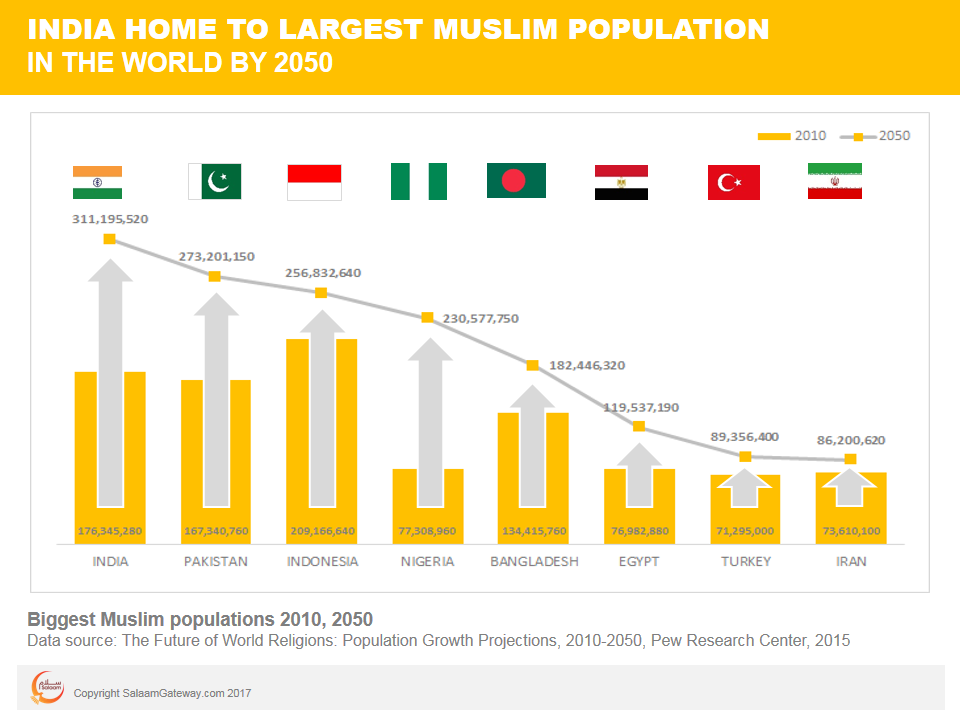Why should the Islamic economy care about population growth?
Indonesia may be home to the world's largest Muslim population today but by 2050 it will be overtaken by South Asian neighbours Pakistan and India, according to Pew Research Center projections.
Pew projects India's Muslim population to grow from 176.35 million in 2010 to 311.2 million by 2050. The large Muslim minority will grow from being 14.4 percent of the country's total population in 2010 to 18.4 percent in 2050.
Pakistan will have the second largest Muslim population in 2050, with the percentage of its Muslim population nudging up marginally from 96.4 percent in 2010 to 96.5 percent in 2050 to reach 273.2 million.
Pew projects Indonesia's Muslim population to dip from 87.2 percent in 2010 to 86.4 percent in 2050, when its Muslim population will reach 256.8 million.
Egypt's Muslim population, the largest in the Arab world, is projected to cross the 100 million mark to hit 119.54 million by 2050, ahead of Turkey's 89.36 million and Iran's 86.2 million.
For Pew's methodology and report click here.
WHY SHOULD THE ISLAMIC ECONOMY CARE ABOUT POPULATION GROWTH?
Pew forecasts the number of Muslims to increase from 24.1 percent of the world, or 1.8 billion, in 2015 to nearly 3 billion in 2060 when they will make up 31.1 percent of the world's people.
Population growth pushes up the demand for food and its cost of production, which will directly impact and affect the entire value chain, from farming to financing to your household grocery bill.
At the top-end, governments and supranational institutions, such as the United Nations and the Organization of Islamic Cooperation (OIC), are addressing food security as a consequence of rising populations, starting with agriculture.
In 2011, researchers from the University of Minnesota forecasted a 100-110 percent increase in global crop demand from 2005 to 2050, warning the actual increase in crop production would likely be in the range of 38-67 percent.
This research showed a bleaker picture than the one released in 2009 by the Food and Agriculture Organization of the United Nations (FAO), which projected global food production, net of food used for biofuels, would have to increase by 70 percent to feed the world's population by 2050.
Doubling food production is technically feasible but the obstacles are formidable, according to a report from The Population Institute.
ISLAMIC ORGANIZATION FOR FOOD SECURITY
Addressing food security obstacles and concerns for Muslim-majority countries, the Organization of Islamic Cooperation (OIC) established the Islamic Organization for Food Security (IOFS) in Astana, Kazakhstan in April 2016.
IOFS's aims include providing expertise and technical know-how to OIC member states on sustainable agriculture, rural development, food security, and biotechnology, as well as to mobilise and manage financial and agricultural resources for developing agriculture and enhancing food security.
In October, the organisation signed a memorandum of understanding (MoU) with the Islamic Corporation for the Development of the Private Sector (ICD) to explore the feasibility of establishing a viable financing platform and business model for mutual collaboration in the implementation of food security, agriculture and rural development projects.
The IOFC has set out a five-year plan that focuses on 'quick-win programmes' aimed at fast-tracking exchanges and cooperation among member states.
India is not a member of the OIC.
© SalaamGateway.com 2017 All Rights Reserved
